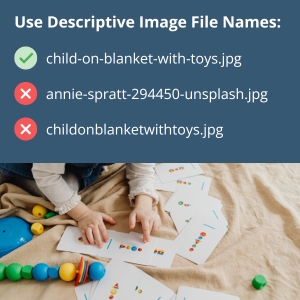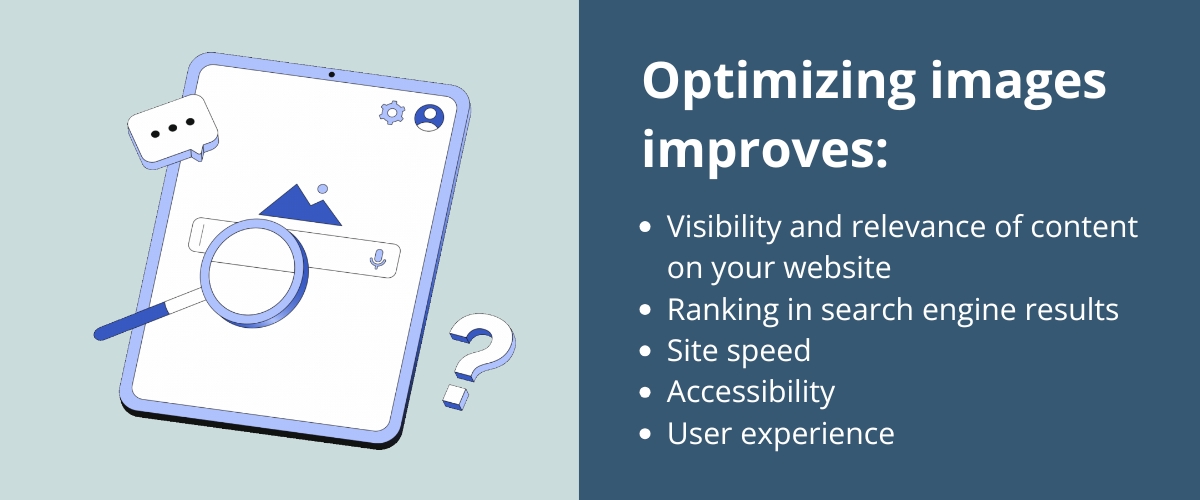As search engines and user search behavior continue to change so do the marketing strategies needed to continue to appear in search results. The growth of image SEO signifies a change in how digital strategists think about search and visual content. Whether it’s because of Google’s shift in image search or simply that the digital space continues to become more visual, here’s what you need to know about nailing your image SEO online.
Why is Image SEO Important?
Optimizing images improves the visibility and relevance of content on your website and can improve their ranking in search engine results, improve your site speed, make your site more accessible, and improve the user experience.
Because search engines continue to emphasize the importance of image SEO, we’ve laid out the following best practices to help you audit your current visual content, build an SEO strategy, and improve on-page performance.
Image SEO Best Practices
There are several important factors to consider when optimizing images on your website. Together, these best practices can enhance both your site’s user experience and its visibility in image-based search results.
1. Use Relevant Images
Google evaluates image relevance based on surrounding text (headings, captions, paragraphs).
For SEO purposes, an image and the web copy or article content should support each other. Relevant image-specific copy will boost the visual asset’s performance, while having a contextual image will help the users understand the context of the content, ensuring a more cohesive message is shared with the reader.
2. Use Descriptive Image File Names
File names are still a ranking signal.
Help Google and screen readers understand your image by naming the file based on what it actually shows. Use an SEO-friendly format for your naming convention: keep filenames in lowercase, separate words with hyphens (not underscores or spaces), and use 5-7 words or fewer.
For Example:
- Good: child-on-blanket-with-toys.jpg
- Bad: annie-spratt-294450-unsplash.jpg
- Bad: childonblanketwithtoys.jpg
3. Match Image Dimensions to Display Size
Matching image dimensions controls how big the image is in pixels to avoid loading unnecessarily large images. This is why it’s important to resize your image’s pixel dimensions to exactly fit the space where it will be displayed on your website or platform.
For example, if an image container is 250px by 350px, the image file itself should be resized to those dimensions before uploading. If you upload a larger image and rely on HTML or CSS to shrink it, the browser still loads the full-size file, which wastes bandwidth and slows down your page. Matching dimensions reduces unnecessary data loading, improving page speed and SEO.
4. Optimize Image File Sizes
Optimizing file size controls how heavy the image file is to ensure quick loading.
Even if an image is the right size, its file can still be too large without proper compression or efficient formatting. Optimizing file size reduces data without losing quality, speeding up page load times and improving SEO. It’s generally best practice to keep files under 500kb.
5. Write Effective Image Alt Tags
Image alternative text (or alt tags) helps search engines understand your images and makes your website more accessible to users with screen readers. To write effective alt text:
- While there aren’t specific word counts or character counts, it’s best to keep your ALT attributes short and descriptive.
- ALT attributes should describe the image, not the surrounding content.
- Use plain, natural language. Write your alt tag like a sentence, using spaces (not dashes or keywords).
- Avoid keyword stuffing. Alt text should be helpful for people, not just optimized for search engines.
6. Include Image Captions (When Necessary)
Image captions can be added to give context. Add captions where it would help the reader, or assist in discovery and understanding. If it visually clutters up the page or repeats the same text in the rest of the content, it is best to leave it off.
7. Use the Correct Image File Type
Choosing the right image format helps balance image quality and website performance.
- JPEG: Best for photos and complex images; offers good quality with smaller file sizes.
- PNG: Ideal for images with transparency or crisp edges, like logos or icons.
- GIF: Use for simple animations or graphics with small dimensions.
- SVG: Perfect for logos, icons, and illustrations that need to scale without losing quality. Great for responsive design.
- WebP: Due to the smaller file sizes, WebP images load faster, which is good for enhanced SEO.
8. Implement Responsive Image Design
Your images should look great on any device a website visitor could use —desktops, tablets, and smartphones. Using responsive image techniques that allow images to automatically adjust based on screen size and resolution gives users the best experience and improves your website’s SEO.
Find Stock Images and Videos For Your Website
Finding relevant stock images can be difficult. Many libraries are filled with generic, overused visuals that don’t quite fit your message or brand. It takes time to sort through them to find images that truly align with your content and resonate with your audience.
Here are some resources we use to help supplement original photography and graphics:
- Adobe Stock: A royalty-free media marketplace offering photos, illustrations, vectors, videos, and templates, seamlessly integrated with Adobe Creative Cloud.
- Pexels: Offers a wide range of high-quality images and videos, all free to use with no attribution required.
- Unsplash: A large library of free, high-resolution images, often curated into themed collections. Great for editorial and creative use.
- Pixabay: Free stock platform offering photos, illustrations, vector graphics, and videos. No attribution required, but check licensing for specific use cases.
- The Stocks: A directory that aggregates links to multiple free image sources. Always review each linked site’s licensing and attribution rules.
- Flickr: A mix of user-generated content with varying licensing. Many images require attribution, so check each image’s license carefully.
- Stocksy: A curated, paid stock photo site known for its artistic, authentic imagery. Great for high-quality, brand-conscious projects.
- iStock: A paid stock photo service from Getty Images, offering affordable royalty-free photos, illustrations, and videos. Subscription or credit-based pricing.
- Getty Images: One of the largest and most trusted paid stock photo libraries, known for editorial, commercial, and premium-quality content. Licensing is more structured and often rights-managed, making it a go-to for high-profile or professional use.
SEO Considerations for AI-Generated Images
Make sure your AI images look natural and professional. If they look fake or distorted, visitors might leave quickly, and that can hurt your SEO. Even when using AI-generated visuals, you still want to follow the same SEO best practices to get the most out of your images.
- Use clear and relevant prompts to make sure the images match your content.
- Rename image files with descriptive names and add helpful alt text.
- Compress images so they load quickly and don’t slow down your site.
- Place images where they actually support your content, not just for decoration.
- Don’t rely only on AI images for things like product photos or team pictures, where real photos build trust.
- Check your images regularly to keep them relevant and optimized.
Following these tips will help you use AI images without hurting your search rankings or user experience.
Learn more about best practices for using AI-generated images in digital marketing.
Stay Visible Online With Image SEO
Optimizing your images isn’t just about looks. It’s about speed, accessibility, and search visibility. By following these best practices, you help your site load faster, reach more people, and perform better in search results. We hope our tips and best practices help you get started!
Need help with your website’s search engine optimization? Reach out to our team.


